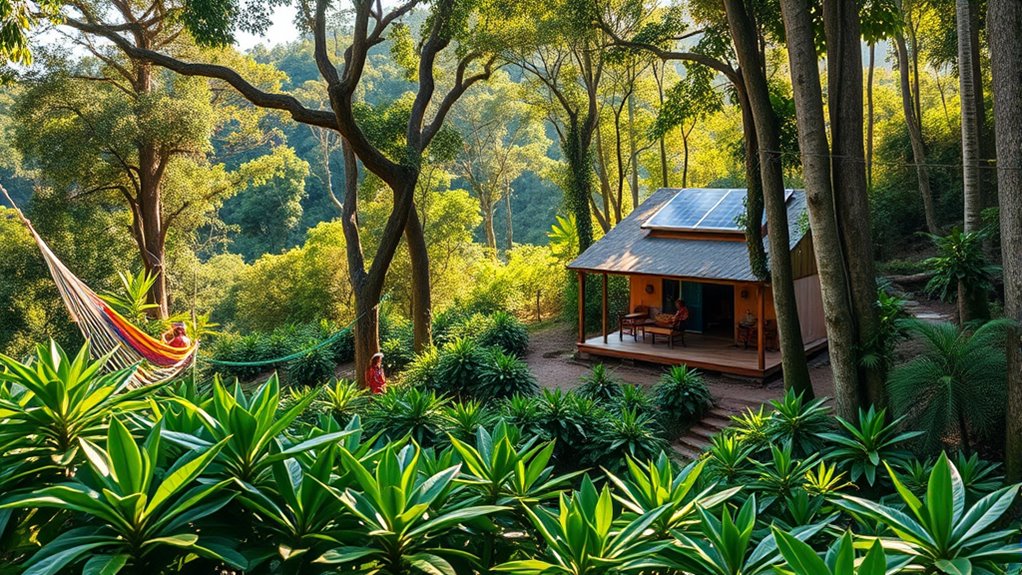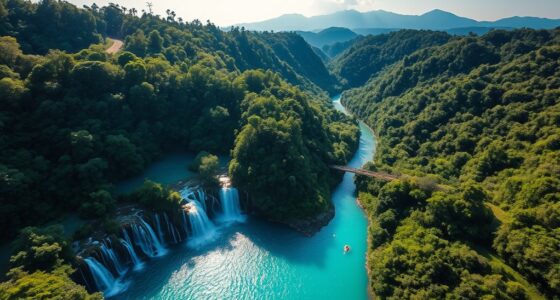Supporting Maya agroforestry projects in southern Mexico involves community participation, donations, and sharing expertise to promote sustainable land use and conserve indigenous knowledge. By getting involved, you help preserve native crops, encourage ecological balance, and improve local livelihoods. These efforts not only protect biodiversity but also strengthen cultural traditions passed down through generations. To make a lasting impact, consider ways to contribute actively—there’s much more to explore beyond the surface.
Key Takeaways
- Participate in community workshops and volunteer programs to promote sustainable agroforestry practices.
- Provide financial support through donations or grants to fund local land management initiatives.
- Share expertise in agriculture, ecology, or indigenous knowledge to enhance project effectiveness.
- Raise awareness about the importance of Maya agroforestry via educational campaigns and social media.
- Collaborate with local groups to ensure projects align with community needs and cultural traditions.
The Importance of Agroforestry for Maya Communities
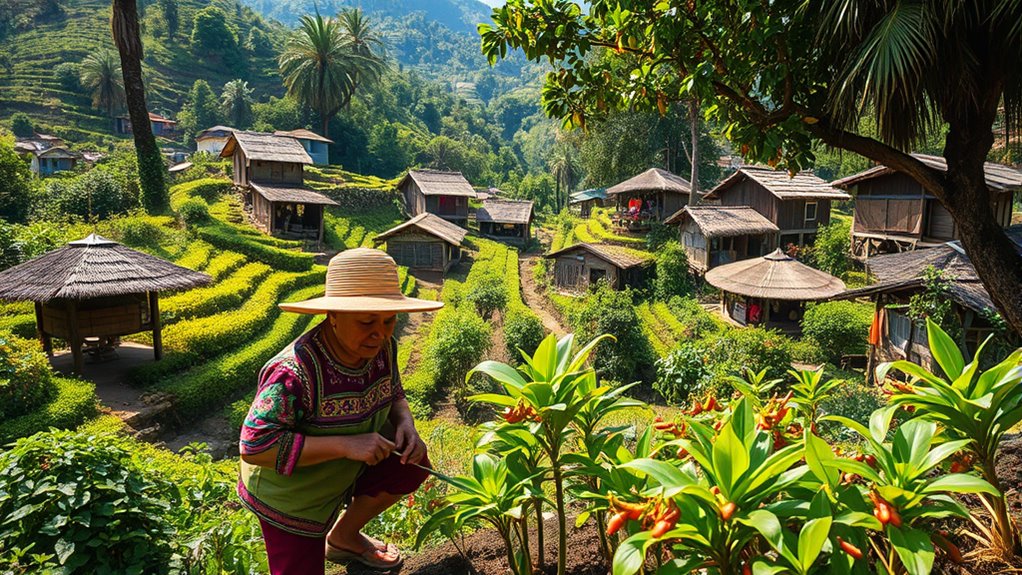
Agroforestry plays a crucial role in supporting Maya communities by enhancing food security and preserving their environment. You can see how traditional practices are at the heart of this system, passed down through generations to sustainably manage land and resources. These practices are essential for maintaining cultural resilience, allowing communities to stay connected to their roots while adapting to modern challenges. By integrating trees with crops and livestock, Maya farmers diversify their sources of food and income, reducing dependency on single crops. This approach also helps conserve soil, water, and biodiversity, ensuring long-term sustainability. Supporting agroforestry empowers you to keep alive these cultural traditions while fostering resilience against climate change and economic pressures. It’s a vital strategy for both survival and cultural preservation. Recognizing the importance of preservation efforts can further enhance the success of these initiatives.
Key Projects and Initiatives in the Region
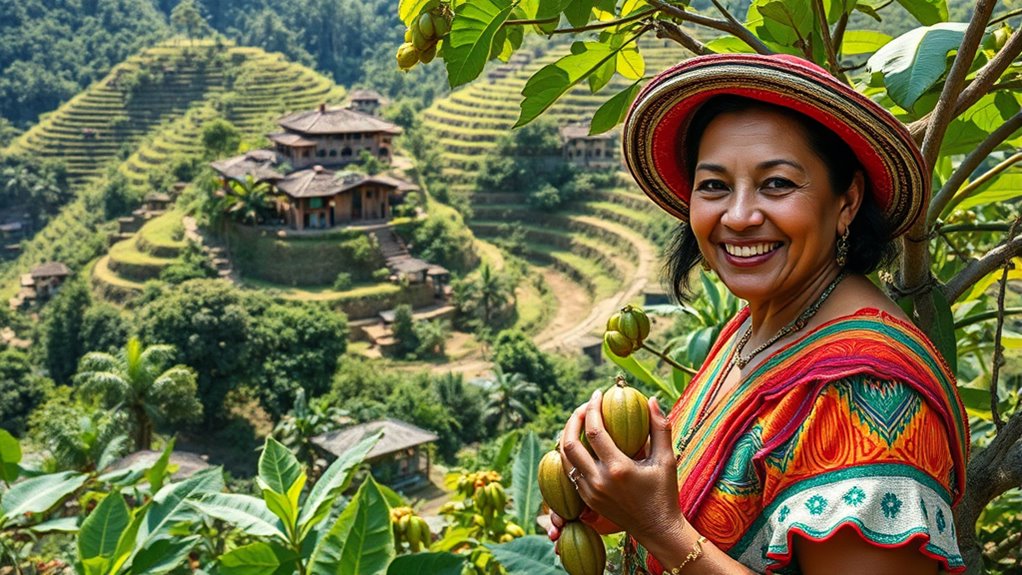
Several key projects and initiatives are transforming the landscape of agroforestry in southern Mexico, directly benefiting Maya communities. These efforts focus on preserving Maya crop diversity, which is essential for local food security and cultural heritage. Initiatives like the Maya Agroforestry Program promote sustainable practices that integrate native crops with forest conservation. By encouraging agroforestry practices that protect surrounding forests, these projects help reduce deforestation and maintain ecosystems. Community-led efforts, supported by NGOs and government agencies, provide training and resources to boost crop diversity and sustainable land use. As a result, Maya farmers can improve yields, strengthen cultural traditions, and contribute to forest conservation. Recognizing the importance of indigenous breeds and local knowledge, these projects foster ecological balance while empowering local communities.
Ways to Support and Get Involved
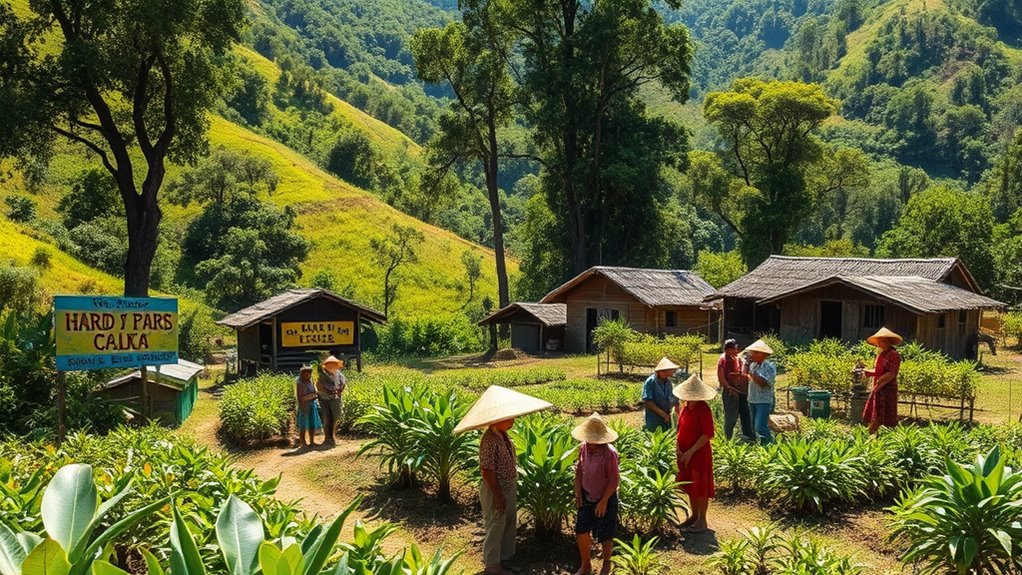
Supporting Maya agroforestry projects offers a meaningful way for individuals and organizations to make a tangible impact. You can get involved through community engagement, volunteering your time, or sharing expertise to strengthen local initiatives. Participating in workshops or educational programs helps raise awareness and builds capacity within the community. Additionally, exploring funding opportunities is essential; you can contribute by donating directly or supporting grants that fund sustainable land use projects. Collaborating with local groups fosters trust and ensures efforts align with community needs. By actively engaging with project leaders and supporting sustainable practices, you help preserve Maya land and culture while promoting ecological resilience. Incorporating high-quality project planning ensures that efforts are effective and sustainable in the long term. Your involvement can truly empower communities and advance their long-term sustainability.
Benefits of Sustainable Land Use for Local Livelihoods

When land is managed sustainably, it directly boosts the livelihoods of local communities by ensuring that natural resources remain productive for generations to come. Sustainable land use promotes soil conservation, preventing erosion and maintaining fertility essential for crop yields. It also enhances biodiversity, creating resilient ecosystems that support diverse plant and animal species, which benefit agriculture and local food security. This approach helps communities adapt to climate change and reduces dependence on external inputs. Consider the table below, illustrating key benefits:
| Benefit | Impact |
|---|---|
| Soil Conservation | Maintains land productivity over time |
| Biodiversity Enhancement | Supports resilient ecosystems |
| Improved Food Security | Ensures stable harvests |
| Economic Stability | Sustains livelihoods |
| Climate Resilience | Minimizes climate-related risks |
Additionally, understanding the importance of best vacuum techniques can serve as a useful analogy for sustainable practices—both require careful management and effective tools to achieve long-term benefits.
Preserving Indigenous Knowledge Through Agriculture

Preserving indigenous knowledge through agriculture plays a crucial role in maintaining sustainable land use and supporting local livelihoods. By integrating traditional farming practices, you help keep alive ancestral skills that promote biodiversity and resilience. These practices often include the use of native plants, which are essential for traditional crafts like basket weaving and pottery. Cultural festivals celebrate this heritage, showcasing traditional crafts and agricultural techniques, reinforcing community identity. Supporting these events encourages the transmission of knowledge from elders to younger generations, ensuring these skills endure. When you prioritize indigenous knowledge, you empower communities to manage their land sustainably, preserve cultural expressions, and sustain their economic independence. Incorporating native plants into farming practices further enhances ecological stability and agricultural diversity. This holistic approach strengthens the connection between land, culture, and livelihood, fostering resilience in Maya communities.
Frequently Asked Questions
How Are Local Governments Involved in Supporting Agroforestry Projects?
Local governments play a vital role in supporting agroforestry projects by developing municipal policies that promote sustainable land use and conservation. They implement funding strategies to provide financial assistance or incentives for farmers adopting agroforestry practices. You can often see them facilitating training programs, offering technical support, and creating partnerships to guarantee these projects thrive. Their involvement helps build community resilience and encourages environmentally friendly farming methods.
What Are the Main Challenges Faced by Maya Farmers Implementing Agroforestry?
You face challenges like soil degradation, which weakens your land’s productivity, and limited market access, making it hard to sell your crops for a fair price. These issues hinder your ability to implement successful agroforestry practices, as maintaining healthy soil and reaching buyers are vital. Overcoming these obstacles requires better resources, training, and support to guarantee your sustainable farming efforts thrive and improve your community’s livelihoods.
How Can International Donors Contribute Effectively to These Initiatives?
This question is vital because your involvement can change everything. You can make a real difference by developing innovative funding strategies that guarantee long-term support. Engage all stakeholders—farmers, local communities, and governments—to create sustainable partnerships. Your efforts can release resources and foster collaboration, turning these projects into thriving, resilient systems. With your dedication, you could help these initiatives grow faster than the speed of light, transforming lives and landscapes alike.
Are There Specific Training Programs for Indigenous Youth in Agroforestry?
You can find specific training programs focused on indigenous education and youth empowerment in agroforestry. These programs teach sustainable farming techniques, conservation, and forest management, empowering indigenous youth to become leaders in their communities. By participating, you help preserve traditional knowledge while promoting environmentally friendly practices. Supporting or volunteering with these initiatives can make a direct impact, ensuring that indigenous youth gain the skills needed to sustain their communities and ecosystems.
What Role Do Women Play in the Success of These Agroforestry Projects?
Women play a crucial role in the success of agroforestry projects by leading efforts in women’s empowerment and cultural preservation. You’ll find that they often serve as stewards of traditional knowledge, ensuring sustainable practices thrive. Their active participation boosts community resilience, promotes gender equality, and preserves cultural heritage, making these projects more effective and sustainable. Recognizing women’s contributions is essential for long-term success and community development.
Conclusion
By supporting Maya agroforestry projects, you help preserve their rich indigenous knowledge and promote sustainable land use. Did you know that integrating traditional practices with modern methods can actually boost crop yields and protect the environment? Your involvement empowers these communities to thrive while maintaining their cultural heritage. Together, we can prove that respecting indigenous wisdom isn’t just respectful—it’s essential for a sustainable future in southern Mexico.

